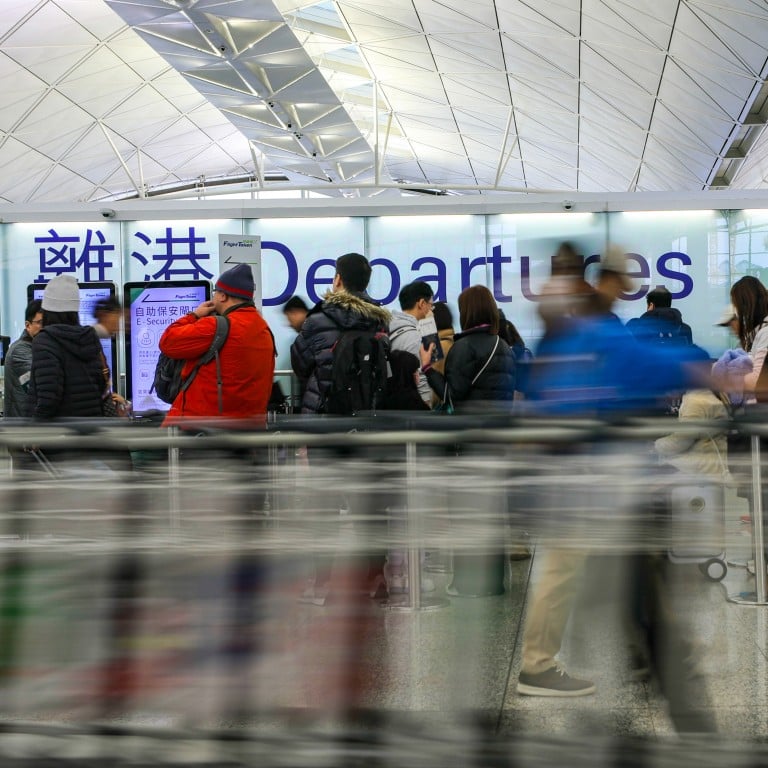
Hong Kong airport ranks fourth for passenger traffic in Asia-Pacific region, city urged to find ‘tourism niche’
- City’s airport comes fourth behind first-placed Singapore, Incheon in South Korea and Suvarnabhumi in Bangkok
- Analysts say city must ‘find its niche’ to attract tourists back amid national economic slowdown if it wants airport to regain No 1 status
Hong Kong’s airport ranked fourth-busiest for international passengers in the Asia-Pacific region last year, and analysts have urged the city to “find its niche” if it hopes to attract more people back and regain its former pole position as the nation grapples with an economic slowdown.
Figures compiled by Singaporean consulting firm Sobie Aviation showed the city’s Changi Airport claimed the top spot in the ranking for 2023, with 58.9 million passengers passing through, 86 per cent of the figure recorded in 2019 before the pandemic hit and upended the global travel industry.
Seoul’s Incheon airport took second place with 55.8 million passengers, 79 per cent of its 2019 level.

Suvarnabhumi airport in Bangkok was third with 40 million passengers, 75 per cent of what was recorded pre-pandemic. Hong Kong ended last year with 39.5 million passengers through the airport, 55 per cent of 2019 levels.
It handled 71.5 million passengers in 2019 and had consistently held the No 1 spot before the pandemic hit. Taiwan Taoyuan airport was fifth with 35.4 million passengers, posting a recovery rate of 73 per cent.
Hong Kong’s recovery rate was the lowest among Asia’s top 10 international airports, having reopened later than other major hubs as it maintained its Covid-19 restrictions for longer, in line with mainland China.
However, last December the airport recorded 75 per cent of the passengers it did that same month in 2019, helped by a bounce from the traditional festive season increase in traffic.
Steven Yiu Siu-chung, an executive director at the Airport Authority, earlier told the Post that Hong Kong was likely to restore its passenger traffic to pre-pandemic levels by the end of the year.
But Sobie Aviation founder Brendan Sobie warned against over-optimism. He said it was too early to say whether Hong Kong’s passenger traffic levels for individual months would reach 2019 levels by the end of this year and that a lot depended on the number of flights from domestic carriers, as well as foreign airlines.
Hong Kong Airport Authority ‘confident’ traffic can hit 2019 level this year
“Hong Kong is very reliant on the Cathay Pacific Group meeting its goals for capacity,” Sobie said. “Cathay Pacific is in the process of doing a lot of hiring … if that slowed down, then Hong Kong as a hub would be impacted.”
Cathay and its budget arm HK Express have set a target of returning to full passenger flight capacity by the end of 2024.
The company last month said it would cancel 12 flights a day on average until the end of February, which the airline said was designed to ensure smooth operations over the Lunar New Year holiday, amid a shortage of experienced pilots.
Overseas carriers have a limited capacity in planes and staffing, so this year they will be “chasing markets where the demand is highest”, Sobie said.
The Board of Airline Representatives of Hong Kong earlier said about 20 per cent of its 72 members had not yet restarted flights to the city as of last December.
Sobie added that Hong Kong reaching fourth spot last year was a significant achievement given expectations for passenger volume at the start of the year and its late reopening to travel.
He predicted Hong Kong’s airport would end 2024 still behind Seoul’s Incheon – which is expected to be the busiest airport in Asia this year – and Singapore’s Changi. But Hong Kong could potentially regain the top spot in 2025, he added.
Gary Ng Cheuk-yan, a senior economist with Natixis Corporate and Investment Bank, predicted the city would only reach 100 per cent of pre-pandemic passenger levels in 2025 at the earliest.
He highlighted obstacles to carriers hiring pilots and cabin crew which prevented them from increasing the supply of flights faster.
“We are heading in the right direction, but I am not too sure about the speed of recovery,” Ng said.
Hong Kong air passenger numbers hit 75 per cent of pre-pandemic figures
He agreed that the mainland’s economic slowdown meant people were not earning as much, so they were less likely to splash out on overseas travel.
Ng said Hong Kong’s air fares and accommodation costs remained high compared with many other Asian cities, which would also dent demand as travellers would opt to go to Thailand or other destinations, which were less expensive.
But Ng said a bright spot was that business travel would continue to improve throughout the year, with more conferences being held in the city.
He said it was vital for the city to boost its tourism industry.
“If the government is able to create more conferences or different types of events then it gives more reasons for people to visit Hong Kong in the short-run,” Ng said. “But, structurally speaking, I do feel Hong Kong needs to find its niche and its charm in attracting people back to the city.”

